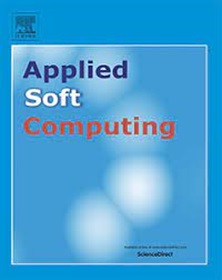用于风险投资选择的带有大规模群体交互测量的犹豫模糊语言偏好一致性驱动共识模型
IF 7.2
1区 计算机科学
Q1 COMPUTER SCIENCE, ARTIFICIAL INTELLIGENCE
引用次数: 0
摘要
最近,基于共识的大规模群体决策(LSGDM)与社会网络、聚类和基于信任的概念研究产生了广泛的互动。本研究为社会网络中的大规模群体决策者(DMs)建立了一个新颖的具有交互度量的犹豫模糊语言偏好一致性驱动的共识模型。首先,通过测量不完整的犹豫模糊语言偏好关系矩阵(HFLPR)之间的相似性来构建有向社会网络。进一步通过社群检测方法,将 DM 分成几个社群。其次,通过探索 HFLPR 矩阵的一致性和 DM 之间的互动信任,建立了一个新的优化模型来估计缺失的元素。第三,通过基于一致性的优化模型,推导出分化社群间不同联盟的二阶加法模糊度量,以捕捉其完全或部分互动。相应地,采用态度 Choquet 积分算子将偏好汇总为集体偏好。第四,设计了一种共识改进机制,以实现以有界信任为特征的 DM 一致同意。通过研究 HFLPRs 的区间一致性,获得了个性化的具体调整量表,为 DMs 的修改提供了支持。最后,以银团风险投资选择为例,进行了相关的模拟分析,以阐明所提方法的可行性和有效性。通过与其他方法的比较,发现了我们建议的优越性和改进性。本文章由计算机程序翻译,如有差异,请以英文原文为准。
Hesitant fuzzy linguistic preference consistency-driven consensus model with large-scale group interaction measure for venture capital investment selection
Recently, consensus-based large-scale group decision making (LSGDM) has been widely interactive with the study of social network, clustering and trust-based concepts. This study develops a novel hesitant fuzzy linguistic preference consistency-driven consensus model with interaction measure for large-scale group decision makers (DMs) in social networks. Firstly, directed social network is constructed by measuring the similarity between incomplete hesitant fuzzy linguistic preference relation (HFLPR) matrices. Community detection method is further conducted to categorize DMs into several communities. Secondly, driven by exploring the consistency of HFLPR matrices and interactive trusts between DMs, a novel optimization model is established to estimate the missing elements. Thirdly, the 2-order additive fuzzy measures of different coalitions between divided communities for capturing their fully or partially interactions are derived by a consistency-based optimization model. Accordingly, the attitudinal Choquet integral operator is employed to aggregate preferences into the collective one. Fourthly, a consensus improving mechanism is devised to achieve the unanimous agreement of DMs characterized by the bounded confidence. Personalized and specific adjustment scales obtained by investigating interval consistency of HFLPRs are provided in support of DMs’ modifications. Finally, an illustrative case on syndicated venture capital investment selection is conducted and related simulation analyses are performed to elucidate the feasibility and validity of the proposed methods. The comparisons with other approaches reveal the superiority and improvement of our proposal.
求助全文
通过发布文献求助,成功后即可免费获取论文全文。
去求助
来源期刊

Applied Soft Computing
工程技术-计算机:跨学科应用
CiteScore
15.80
自引率
6.90%
发文量
874
审稿时长
10.9 months
期刊介绍:
Applied Soft Computing is an international journal promoting an integrated view of soft computing to solve real life problems.The focus is to publish the highest quality research in application and convergence of the areas of Fuzzy Logic, Neural Networks, Evolutionary Computing, Rough Sets and other similar techniques to address real world complexities.
Applied Soft Computing is a rolling publication: articles are published as soon as the editor-in-chief has accepted them. Therefore, the web site will continuously be updated with new articles and the publication time will be short.
 求助内容:
求助内容: 应助结果提醒方式:
应助结果提醒方式:


